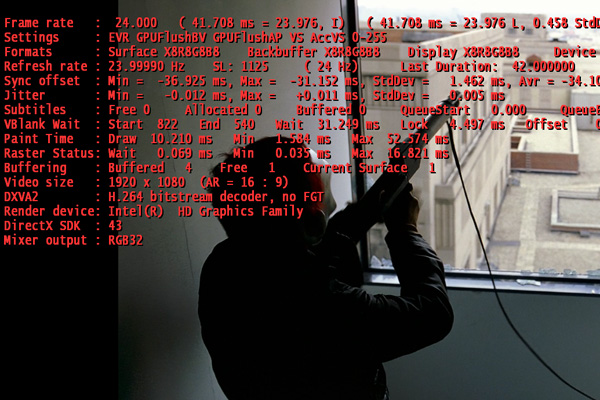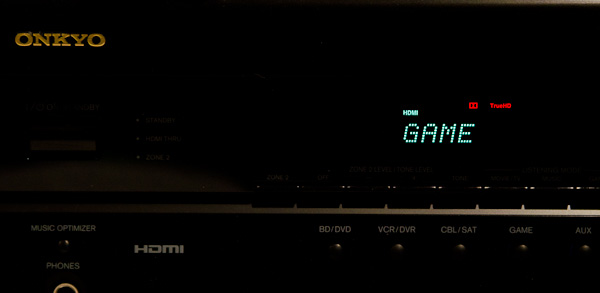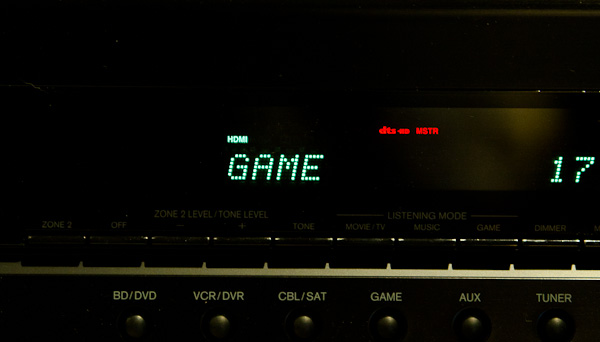The Sandy Bridge Review: Intel Core i7-2600K, i5-2500K and Core i3-2100 Tested
by Anand Lal Shimpi on January 3, 2011 12:01 AM ESTA Near-Perfect HTPC
Since 2006 Intel’s graphics cores have supported sending 8-channel LPCM audio over HDMI. In 2010 Intel enabled bitstreaming of up to eight channels of lossless audio typically found on Blu-ray discs via Dolby TrueHD and DTS-HD MA codecs. Intel’s HD Graphics 3000/2000 don’t add anything new in the way of audio or video codec support.
Dolby Digital, TrueHD (up to 7.1), DTS, DTS-HD MA (up to 7.1) can all be bitstreamed over HDMI. Decoded audio can also be sent over HDMI. From a video standpoint, H.264, VC-1 and MPEG-2 are all hardware accelerated. The new GPU enables HDMI 1.4 and Blu-ray 3D support. Let’s run down the list:
Dolby TrueHD Bitstreaming? Works:
DTS HD-MA bitstreaming? Yep:
Blu-ray 3D? Make that three:
How about 23.976 fps playback? Sorry guys, even raking in $11 billion a quarter doesn’t make you perfect.
Here’s the sitch, most movie content is stored at 23.976 fps but incorrectly referred to as 24p or 24 fps. That sub-30 fps frame rate is what makes movies look like, well, movies and not soap operas (this is also why interpolated 120Hz modes on TVs make movies look cheesey since they smooth out the 24 fps film effect). A smaller portion of content is actually mastered at 24.000 fps and is also referred to as 24p.
In order to smoothly playback either of these formats you need a player and a display device capable of supporting the frame rate. Many high-end TVs and projectors support this just fine, however on the playback side Intel only supports the less popular of the two: 24.000Hz.
This isn’t intentional, but rather a propagation of an oversight that started back with Clarkdale. Despite having great power consumption and feature characteristics, Clarkdale had one glaring issue that home theater enthusiasts discovered: despite having a 23Hz setting in the driver, Intel’s GPU would never output anything other than 24Hz to a display.
The limitation is entirely in hardware, particularly in what’s supported by the 5-series PCH (remember that display output is routed from the processor’s GPU to the video outputs via the PCH). One side effect of trying to maintain Intel’s aggressive tick-tock release cadence is there’s a lot of design reuse. While Sandy Bridge was a significant architectural redesign, the risk was mitigated by reusing much of the 5-series PCH design. As a result, the hardware limitation that prevented a 23.976Hz refresh rate made its way into the 6-series PCH before Intel discovered the root cause.
Intel had enough time to go in and fix the problem in the 6-series chipsets, however doing so would put the chipset schedule at risk given that fixing the problem requires a non-trivial amount of work to correct. Not wanting to introduce more risk into an already risky project (brand new out of order architecture, first on-die GPU, new GPU architecture, first integrated PLL), Intel chose to not address it this round, which is why we still have the problem today.

Note the frame rate
What happens when you try to play 23.976 fps content on a display that refreshes itself 24.000 times per second? You get a repeated frame approximately every 40 seconds to synchronize the source frame rate with the display frame rate. That repeated frame appears to your eyes as judder in motion, particularly evident in scenes involving a panning camera.
How big of an issue this is depends on the user. Some can just ignore the judder, others will attempt to smooth it out by setting their display to 60Hz, while others will be driven absolutely insane by it.
If you fall into the latter category, your only option for resolution is to buy a discrete graphics card. Currently AMD’s Radeon HD 5000 and 6000 series GPUs correctly output a 23.976Hz refresh rate if requested. These GPUs also support bitstreaming Dolby TrueHD and DTS-HD MA, while the 6000 series supports HDMI 1.4a and stereoscopic 3D. The same is true for NVIDIA’s GeForce GT 430, which happens to be a pretty decent discrete HTPC card.
Intel has committed to addressing the problem in the next major platform revision, which unfortunately seems to be Ivy Bridge in 2012. There is a short-term solution for HTPC users absolutely set on Sandy Bridge. Intel has a software workaround that enables 23.97Hz output. There’s still a frame rate mismatch at 23.97Hz, but it would be significantly reduced compared to the current 24.000Hz-only situation.
MPC-HC Compatibility Problems
Just a heads up. Media Player Classic Home Cinema doesn't currently play well with Sandy Bridge. Enabling DXVA acceleration in MPC-HC will cause stuttering and image quality issues during playback. It's an issue with MPC-HC and not properly detecting SNB as far as I know. Intel has reached out to the developer for a fix.














283 Comments
View All Comments
hmcindie - Monday, January 3, 2011 - link
Why is that Quick Sync has better scaling? Very evident in the Dark Knight police car image as all the other versions have definite scaling artifacts on the car.Scaling is something that should be very easy. Why is there so big a difference? Are these programs just made to market new stuff and no-one really uses them because they suck? So big scaling differences between codepaths make no sense.
JarredWalton - Monday, January 3, 2011 - link
It looks to me like some of the encodes have a sharpening effect applied, which is either good (makes text legible) or bad (aliasing effects) depending on your perspective. I'm quite happy overall with the slightly blurrier QS encodes, especially considering the speed.xxxxxl - Monday, January 3, 2011 - link
I've been so looking forward to SB...only to hear that H67 cant overclock CPU?!?!?!?!Disappointed.
digarda - Monday, January 3, 2011 - link
Who needs the IGP for a tuned-up desktop PC anyway? Some for sure, but I see the main advantages of the SB GPU for business laptop users. As the charts show, for desktop PC enthusiasts, the GPU is still woefully slow, being blown away even by the (low-end) Radeon 5570. For this reason, I can't help feeling that the vast majority of overclockers will still want to have discrete graphics.I would have preferred to dual core (4-thread) models to have (say) 32 shaders, instead of the 6 or 12 being currently offered. At 32nm, there's probably enough silicon real estate to do it. I guess Intel simply didn't want the quad core processors to have a lower graphics performance than the dual core ones (sigh).
Pity that the socket 2011 processors (without a GPU) are apparently not going to arrive for nearly a year (Q4 2011). I had previously thought the schedule was Q3 2011. Hopefully, AMD's Bulldozer-based CPUs will be around (or at least imminent) by then, forcing intel to lower the prices for its high-end parts. On the other hand, time to go - looks like I'm starting to dream again...
Exodite - Monday, January 3, 2011 - link
Using myself as an example showing the drawback of limiting overclocking on H67 would be the lack of a good selection of overclocking-friendly micro-ATX boards due to most, if not all, of those being H67.Granted, that's not Intel's fault.
It's just that I have no need for more than one PCIe x16 slot and 3 SATA (DVD, HDD, SSD). I don't need PCI, FDD, PS2, SER, PAR or floppy connectors at all.
Which ideally means I'd prefer a rather basic P67 design in micro-ATX format but those are, currently, in short supply.
The perfect motherboard, for me, would probably be a P67 micro-ATX design with the mandatory x8/x8 Crossfire support, one x1 and one x4 slot, front panel connector for USB 3, dual gigabit LAN and the base audio and SATA port options.
Gigabyte?
Anyone? :)
geofelt - Monday, January 3, 2011 - link
The only P67 based micro-ATX motherboard I have found to date is theAsus P8P67-M pro. (or evo?)
Any others?
Rick83 - Monday, January 3, 2011 - link
There's also a non-pro P8P67-M.Keep in mind though, that the over-clocking issue may not be as bad as pointed out. There are H67 boards being marketed for over-clocking ability and manuals showing how to adjust the multiplier for CPUs... I'm not yet convinced over-clocking will be disabled on H67.
smilingcrow - Monday, January 3, 2011 - link
Major bummer as I was going to order a Gigabyte H67 board and an i5-2500K but am put off now. They seem to over-clock so well and with low power consumption that it seemed the perfect platform for me…I don’t mind paying the small premium for the K editions but being forced to use a P67 and lose the graphics and have difficulty finding a mATX P67 board seems crazy!
I wonder if this limit is set in the chipset or it can be changed with a BIOS update?
DanNeely - Monday, January 3, 2011 - link
Quick Sync only works if the IGP is in use (may be fixable via drivers later); for anyone who cares about video encoding performance that makes the IGP a major feature.mariush - Monday, January 3, 2011 - link
On the Dark Knight test...Looking at the Intel software encoding and the AMD encoding, it looks like the AMD is more washed out overall, which makes me think there's actually something related to colorspaces or color space conversion involved....
Are you guys sure there's no PC/TV mixup there with the luminance or ATI using the color matrix for SD content on HD content or something like that?